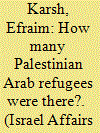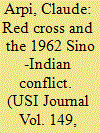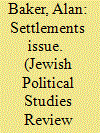|
|
|
Sort Order |
|
|
|
Items / Page
|
|
|
|
|
|
|
| Srl | Item |
| 1 |
ID:
103230


|
|
|
|
|
| Publication |
2011.
|
| Summary/Abstract |
The number of Palestinian Arabs fleeing their homes during the 1948 war has constituted one of the most intractable bones of contention of the Arab-Israeli conflict, not least since the Palestinians have insisted on the 'right of return' of these individuals and their descendants to territory that has long been part of the state of Israel. At the end of the war, the Israeli government set the number of Palestinian refugees at 550,000-600,000; the British Foreign Office leaned toward the higher end of this estimate. But within a year, as large masses of people sought to benefit from the unprecedented influx of international funds to the area, some 962,000 alleged refugees had been registered with the newly-established UN Relief and Works Agency (UNRWA). More than a half-century later, these exaggerated initial numbers have swollen still further: as of June 2000, according to UNRWA, the total had climbed close to 3.75 million, though it readily admits that the statistics are largely inflated. For its part the PLO set a still higher figure of 5 million refugees, while Israel has unofficially estimated the current number of refugees and their families at closer to 2 million. Using a wealth of declassified Arab, Israeli, and British documents, this article seeks to provide as comprehensive and accurate an estimate as possible of the actual number of refugees in the wake of the 1948 war.
|
|
|
|
|
|
|
|
|
|
|
|
|
|
|
|
| 2 |
ID:
170773


|
|
|
|
|
| Summary/Abstract |
For the Indian nation, the 1962 conflict with China has been one of the most traumatic post-independence events. For more than 3,000 prisoners of war (PoWs), the experience was particularly harrowing.
This article looks at difficult relations between the International Committee of the Red Cross (ICRC) in Geneva, the Indian Red Cross (IRC) and the Chinese Red Cross (CRC) Society. The ICRC’s archives in Geneva helped to understand the role of the international organization as well as of the two national Red Crosses and their respective governments during the conflict.
China not only refused to officially acknowledge the Geneva Convention of 1949 on PoWs, but also committed several violations in respect of the treatment meted out to captured Indian military personnel.
27 Military officers taken PoWs during operations were taken on a tour of china and repatriated on 04 May 1963.
The rosy picture painted by the Chinese propaganda had actually been a traumatic experience for the Indian PoWs.
|
|
|
|
|
|
|
|
|
|
|
|
|
|
|
|
| 3 |
ID:
160317


|
|
|
| 4 |
ID:
164789


|
|
|
|
|
| Summary/Abstract |
This article discusses the origins of the Army Nurse Corps in the Spanish-American War and the contributions of the Daughters of the American Revolution Hospital Corps. This organization was a vital proponent of employing contract nurses as medical auxiliaries, women whose service demonstrated both the capability of, and necessity for, female nurses in the military. The article also addresses the role of the American Red Cross in providing medical support, but concludes that tensions over control of transportation, supplies, and personnel drove the Army away from voluntary aid and toward creating a professional nurse corps within its Medical Department.
|
|
|
|
|
|
|
|
|
|
|
|
|
|
|
|
| 5 |
ID:
186601


|
|
|
|
|
| Summary/Abstract |
The Korean War (1950–1953) was one of the most calamitous and brutal wars in modern history. It was fought by the post-colonial people of the peninsula, and it culminated in the creation of two ideologically opposed states, but the three years’ military clash in East Asia (or the Far East) is often labelled simply as a “Forgotten War” in the West including North America. The ensuing ethnic division has been interpreted through the various geopolitical lenses of military strategy, politics, international relations, and power games. What about the situation of casualties? Which particular nations in the United Nations (UN) dispatched medical aid for the treatment of war victims? How did the Scandinavian allies participate the non-European war? What were their unique characteristics among non-military supporting nations? What legacy they left for the post-war Koreans? This paper explores the military-historical backgrounds by which each of the following Northern European nation, namely, Sweden, Denmark, and Norway, decided to send unarmed skilled personnel to aid South Korea. The paper argues the social voluntarism of the neutral group in the critical insight that the field activities of Swedish Seojeon Byungwon, Danish Jutlandia, and Norwegian NORMASH individually promoted the Red Cross spirit of advanced humanitarianism on the top of mandatory duty, in giving special attention on children (orphans), women, civilians, POWs, and medical education, as well as the post-war collaboration for the initial Korean public health system in the 1960s.
|
|
|
|
|
|
|
|
|
|
|
|
|
|
|
|
| 6 |
ID:
124364


|
|
|
|
|
| Publication |
2011.
|
| Summary/Abstract |
It is claimed that settlements are a violation of the Fourth Geneva Convention Relative to the Protection of Civilians (1949). But both the text of that convention, and the post - World War II circumstances under which it was drafted, clearly indicate that it was never intended to refer to situations like Israel's settlements. According to the International Committee of the Red Cross, Article 49 relates to situations where populations are coerced into being transferred. There is nothing to link such circumstances to Israel's settlement policy. A special regime between Israel and the Palestinians is set out in a series of agreements negotiated between 1993 and 1999 that are still valid-that govern all issues between them, settlements included. In this framework there is no specific provision restricting planning, zoning, and continued construction by either party. The Palestinians cannot now invoke the Geneva Convention regime in order to bypass previous internationally acknowledged agreements.
|
|
|
|
|
|
|
|
|
|
|
|
|
|
|
|
|
|
|
|
|